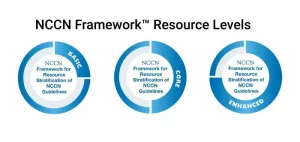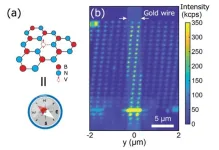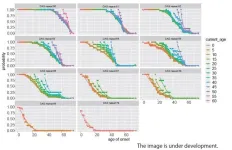(Press-News.org) PLYMOUTH MEETING, PA and LONDON, UK [June 14, 2023] — The National Comprehensive Cancer Network® (NCCN®) is introducing a new global resource to improve thyroid cancer care in low- and middle-income countries at the upcoming World Congress on Thyroid Cancer, in London. During the event, NCCN Senior Vice President and Chief Medical Officer, Wui-Jin Koh, MD, will present on NCCN’s ongoing global work to define and advance high-quality, high-value, patient-centered cancer care. As part of that work, the non-profit alliance of leading cancer centers recently published the new NCCN Framework for Resource Stratification of NCCN Guidelines (NCCN Framework™) for Thyroid Carcinoma, available free-of-charge at NCCN.org/global. The new resource will debut in front of more than 1,000 cancer care providers from across the globe on June 17, 2023.
NCCN Framework™ exists for numerous cancer types—covering more than 80 percent of cancer diagnoses—plus supportive care topics such as pain management, palliative care, and breast cancer prevention and detection. The NCCN Framework™ for Thyroid Carcinoma is the first new cancer type to be added to this library in recent years. More than 500,000 people are diagnosed with thyroid cancer worldwide every year.1 The NCCN Framework™ for Thyroid Carcinoma provides guidance on the optimal treatment approach for differentiated thyroid cancers in resource-constrained settings.
“The NCCN Framework establishes a realistic baseline of care tailored to various resource levels. It also showcases which future investments could be most effective,” said Robert W. Carlson, MD, Chief Executive Officer, NCCN. “These tools represent NCCN’s longstanding commitment to improving equity and outcomes for people with cancer, no matter where they live. More than 800,000 registered users outside the United States rely on the NCCN Guidelines to provide the latest evidence-based expert consensus cancer treatment recommendations. We want to make sure we’re providing accessible advice which improves outcomes for everyone.”
“The state-of-the-art NCCN Guidelines are widely used and respected worldwide—but the full recommendations aren’t always feasible in lower resource settings,” said World Congress on Thyroid President Gregory W. Randolph, MD, FACS, FACE, FEBS (Endocrine), MAMSE, Professor of Otolaryngology Head and Neck Surgery, Claire and John Bertucci Endowed Chair in Thyroid Surgical Oncology, Harvard Medical School. “The World Congress on Thyroid Cancer brings together hundreds of care providers from all around the world. This year, instead of just talking about the inapplicability of guidelines intended for high-resource environments, we’re introducing a solution… the new NCCN Framework for Thyroid Carcinoma. We feel this represents a global solution to thyroid cancer guidelines. The World Congress on Thyroid Cancer has forged a relationship that has been so gratifying and positive we’re committed to keep working with NCCN going forward.”
The NCCN Framework™ stratify the gold-standard recommendations from the NCCN Clinical Practice Guidelines in Oncology (NCCN Guidelines®) into 3 different resource levels (Basic, Core and Enhanced). The recommendations at each level are color-coded so that the resource stratified recommendations can be viewed within the context of the NCCN Guidelines®. The NCCN Framework™ resources are defined as follows:
Basic resources—Essential services needed to provide basic minimal standard of care.
Core resources—Includes services provided in the Framework for Basic Resources plus additional services that provide major improvements in disease outcomes (e.g. survival) that are not cost-prohibitive.
Enhanced resources—Services provided in the Framework for Core Resources and additional services that provide lesser improvements in disease outcomes and/or services that provide major improvements in disease outcomes but are cost-prohibitive in lower resource settings.
Robert I. Haddad, MD, Division Chief, Center for Head and Neck Oncology at the Dana Farber Cancer Institute in Boston and Professor of Medicine, Harvard Medical School, is the Chair of the multi-disciplinary panel of experts from across NCCN’s Member Institutions responsible for updating and maintaining the NCCN Guidelines for Thyroid Carcinoma. He also took a lead role in creating the NCCN Framework™ for Thyroid Carcinoma and will join Dr. Koh at the World Congress to present this new resource.
“We analyze all of the available evidence and review it with our colleagues and fellow panel members at least once a year, and sometimes more often, to make sure the NCCN Guidelines reflect the very latest research and best practices,” said Dr. Haddad. “In the process of developing this NCCN Framework, we worked with the World Congress on Thyroid Cancer to solicit feedback from all over the world. We really appreciate everyone’s efforts helping us set standards for optimally tailoring resource-stratified recommendations to maximally benefit all people with thyroid cancer globally.”
NCCN currently has more than 250 translations of clinical resources across 69 languages in addition to NCCN International Adaptations and NCCN Harmonized Guidelines™ (which are similar to NCCN Framework™ but created for specific regions in joint efforts with local experts). View these free resources and learn more about NCCN’s collaborative work to define and advance high-quality, high-value, patient-centered cancer care globally at NCCN.org/global.
# # #
About the National Comprehensive Cancer Network
The National Comprehensive Cancer Network® (NCCN®) is a not-for-profit alliance of leading cancer centers devoted to patient care, research, and education. NCCN is dedicated to improving and facilitating quality, effective, equitable, and accessible cancer care so all patients can live better lives. The NCCN Clinical Practice Guidelines in Oncology (NCCN Guidelines®) provide transparent, evidence-based, expert consensus recommendations for cancer treatment, prevention, and supportive services; they are the recognized standard for clinical direction and policy in cancer management and the most thorough and frequently-updated clinical practice guidelines available in any area of medicine. The NCCN Guidelines for Patients® provide expert cancer treatment information to inform and empower patients and caregivers, through support from the NCCN Foundation®. NCCN also advances continuing education, global initiatives, policy, and research collaboration and publication in oncology. Visit NCCN.org for more information.
[1] https://www.thelancet.com/journals/landia/article/PIIS2213-8587(22)00035-3/fulltext#back-bib1
END
SEATTLE, Wash. – Quitting alcohol or drugs was not a top priority for people experiencing homelessness in a harm reduction treatment study, yet participants still reduced their use of both.
A different approach than traditional abstinence-based programs, harm reduction treatment for alcohol use disorder, also called HaRT-A, has patients set their own goals. In a study of 308 people experiencing homelessness, the participants receiving harm reduction treatment set goals of meeting basic needs and improving quality of life well above quitting alcohol and other substances.
Yet harm reduction treatment still led to more reduced use compared to a control group who received ...
The Maynooth University Foundation is delighted to announce a significant donation from Intel Ireland to support the creation of a state-of-the-art robotics lab. The lab will provide MU students with invaluable hands-on learning experiences using cutting-edge robotic technologies.
The establishment of the robotics lab at a total cost of €150,000 will equip Maynooth University students with access to innovative robotic technologies and equipment used by engineers from Intel and other companies. This hands-on experience will enable them to bridge the gap between classroom learning and real-world application, empowering them to develop and refine their skills in robotics.
The ...
Beta-2 agonists are bronchodilators commonly used in the treatment of asthma and chronic obstructive pulmonary disease (COPD). Although beta-2 agonists have been associated with a reduced risk of Parkinson’s disease in some previous epidemiological studies, this association was not found in a recent register-based study from the University of Eastern Finland. The findings were published in Clinical Epidemiology.
Accumulation of the alpha-synuclein protein in the brain plays a central role in Parkinson’s ...
Put yourself in the exoskeleton of a bumblebee for a moment: your world would be a riot of colors and scents, both essential to guide your search for pollen and nectar. Bumblebees have excellent vision: they have a pair of compound eyes that can distinguish UV and most colors except red, plus three additional simple eyes specialized in detecting polarized light. Their sense of smell dwarfs ours: approximately 100 times more sensitive, and capable of sniffing out illegal drugs or explosives at airports, confirming pregnancy in women, or detecting cancers and diabetes in early-stage patients.
Now, ...
All living cells contains proteins with different functions, depending on the type of cell. Researchers at the University of Gothenburg have discovered a way to identify proteins even without looking at their structure. Their method is faster, easier and more reliable than previous methods.
Currently, the general view is that each protein’s structure is what controls its function in cells. The atomic sequences, meaning how the atoms are arranged in the proteins, create the protein’s structure and shape. But there are many proteins that lack a well-defined structure.
Researcher Gergely Katona ...
Summary: The University of Tokyo scientists achieve the delicate task of arranging quantum sensors at a nanoscale, allowing them to detect extremely small variations in magnetic fields. The high-resolution quantum sensors will have potential uses in quantum materials and electronic device research. For example, the sensors can help develop hard disks that use nano-magnetic materials as storage elements. This is the world’s first successful high-resolution magnetic field imaging using a nanoscale arrangement of quantum sensors.
Sensors surround us in our daily life, from garage lights ...
WASHINGTON (June 14, 2023) – More than 500 adolescent mothers, caregivers and community members benefitted from a coordinated “collective impact” model to provide support aimed at addressing the litany of strains faced by teen parents, according to a case study published Wednesday in the journal Pediatrics.
Known as the District of Columbia Network for Parenting and Expectant Teens (DC NEXT), the model used well-tested pillars of community organization to provide services and care that bolstered the well-being of pregnant ...
A University of Waterloo engineer’s MRI invention reveals better than many existing imaging technologies how COVID-19 can change the human brain.
The new imaging technique known as correlated diffusion imaging (CDI) was developed by systems design engineering professor Alexander Wong and recently used in a groundbreaking study by scientists at Baycrest’s Rotman Research Institute and Sunnybrook Hospital in Toronto.
“Some may think COVID-19 affects just the lungs,” Dr. Wong said. “What was found is that this new MRI technique that we created ...
Niigata, Japan – Using machine learning, the Department of Neurology at Niigata University has developed a model to predict the asymptomatic probability at each age from the current age and number of CAG repeats in carriers of spinocerebellar degeneration. Polyglutamine diseases such as DRPLA and SCA3 are caused by an expansion of CAG repeats in the causative gene. In polyglutamine diseases, the number of CAG repeats is known to be inversely related to age of onset. Parametric survival analysis has traditionally been used to predict age of onset, but a more accurate prediction method has been desired. We ...
Niigata, Japan - The phenomenon of improvement of glucose to levels in a normal range and cessation of the need for medication can occur in some patients diagnosed with type 2 diabetes who are provided with lifestyle therapy, temporary pharmacotherapy, bariatric surgery, or combinations of these treatments. However, this phenomenon is not yet fully understood in routine care settings, and many factors remain to be clarified. Moreover, since there are differences in insulin secretion and resistance between East Asian and Western populations, the natural history of diabetes seems to differ widely between Western populations and East Asians.
Therefore, ...




